OPMA 5361 - Business Analytics: Disruptive Technologies in Operations
VerifiedAdded on 2023/06/15
|14
|1736
|311
Project
AI Summary
This project provides an overview of business analytics and its disruptive effects on operations management. It defines business analytics, highlighting its role in data-driven decision-making and competitive advantage. The project discusses the current state of technology, potential applications such as customer segmentation, risk assessment, churn prevention, sales forecasting, market surveys, and financial modeling, along with the limitations of business analytics, including correlation errors and data leakage. It also references a video explaining the importance of business analytics in understanding business decisions. The project concludes that while business analytics is a useful tool, proper data collection, storage, and security are crucial for its effective implementation in various sectors like finance, sales, and marketing.
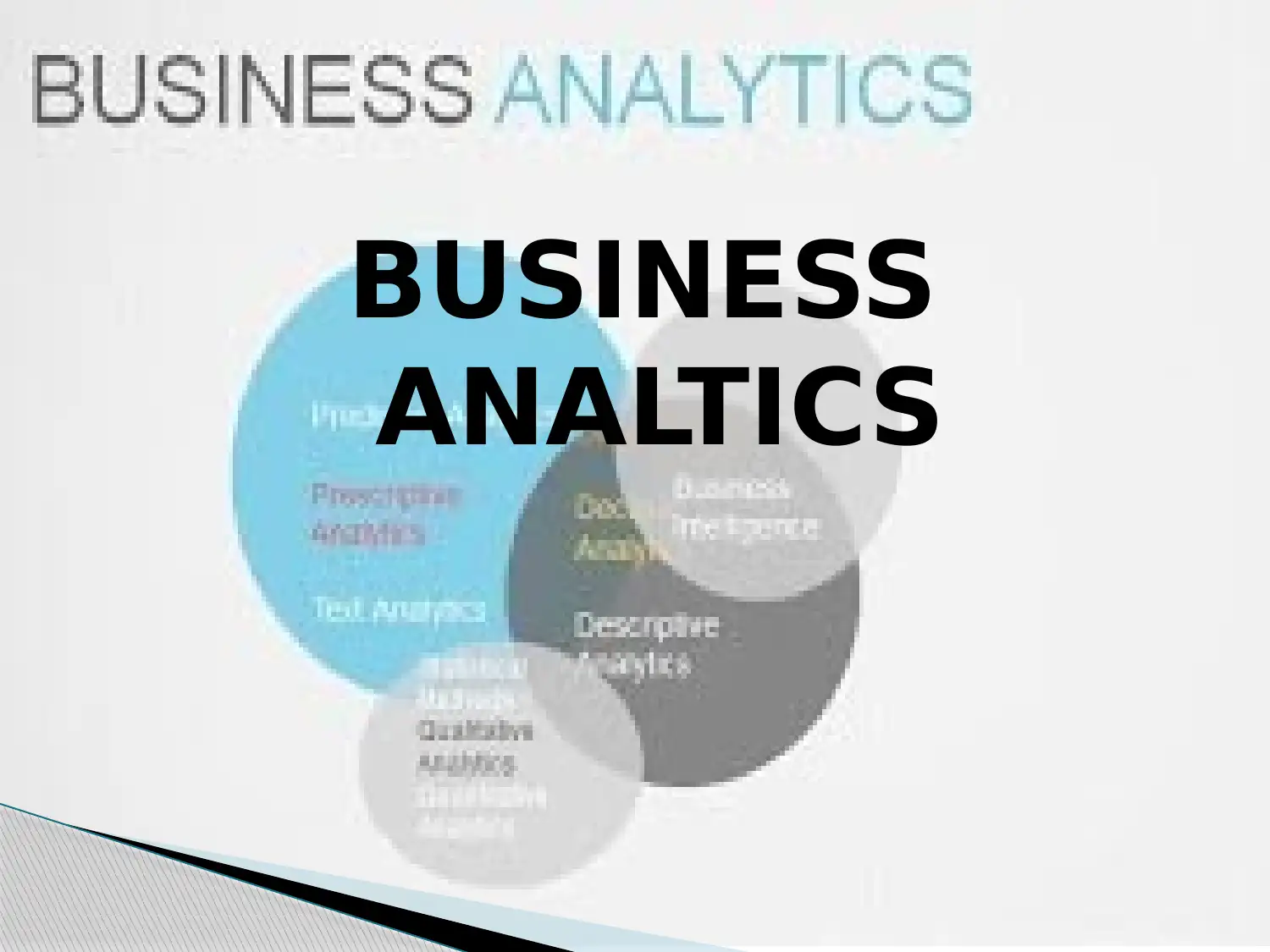
BUSINESS
ANALTICS
ANALTICS
Paraphrase This Document
Need a fresh take? Get an instant paraphrase of this document with our AI Paraphraser
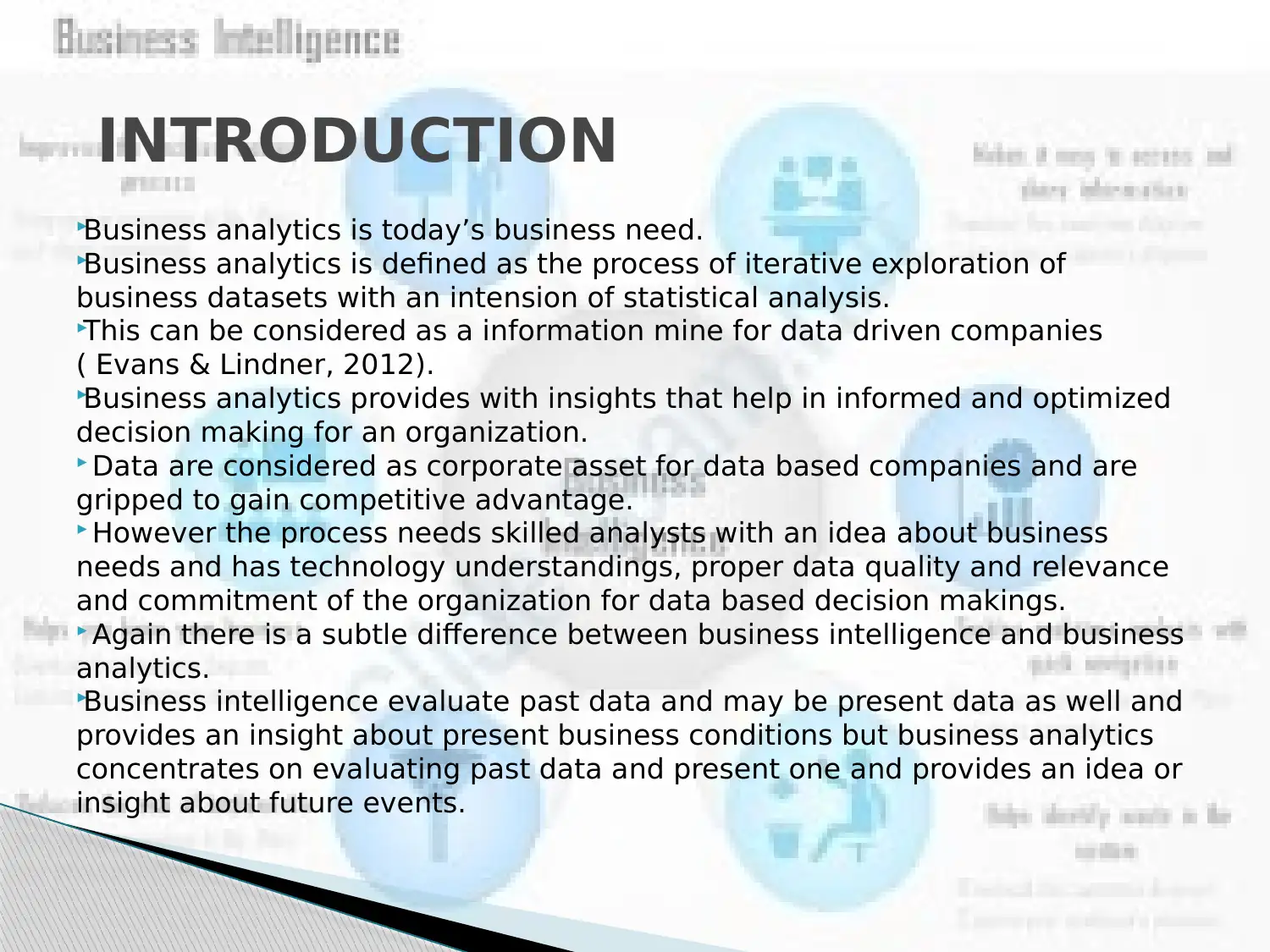
Business analytics is today’s business need.
Business analytics is defined as the process of iterative exploration of
business datasets with an intension of statistical analysis.
This can be considered as a information mine for data driven companies
( Evans & Lindner, 2012).
Business analytics provides with insights that help in informed and optimized
decision making for an organization.
Data are considered as corporate asset for data based companies and are
gripped to gain competitive advantage.
However the process needs skilled analysts with an idea about business
needs and has technology understandings, proper data quality and relevance
and commitment of the organization for data based decision makings.
Again there is a subtle difference between business intelligence and business
analytics.
Business intelligence evaluate past data and may be present data as well and
provides an insight about present business conditions but business analytics
concentrates on evaluating past data and present one and provides an idea or
insight about future events.
INTRODUCTION
Business analytics is defined as the process of iterative exploration of
business datasets with an intension of statistical analysis.
This can be considered as a information mine for data driven companies
( Evans & Lindner, 2012).
Business analytics provides with insights that help in informed and optimized
decision making for an organization.
Data are considered as corporate asset for data based companies and are
gripped to gain competitive advantage.
However the process needs skilled analysts with an idea about business
needs and has technology understandings, proper data quality and relevance
and commitment of the organization for data based decision makings.
Again there is a subtle difference between business intelligence and business
analytics.
Business intelligence evaluate past data and may be present data as well and
provides an insight about present business conditions but business analytics
concentrates on evaluating past data and present one and provides an idea or
insight about future events.
INTRODUCTION
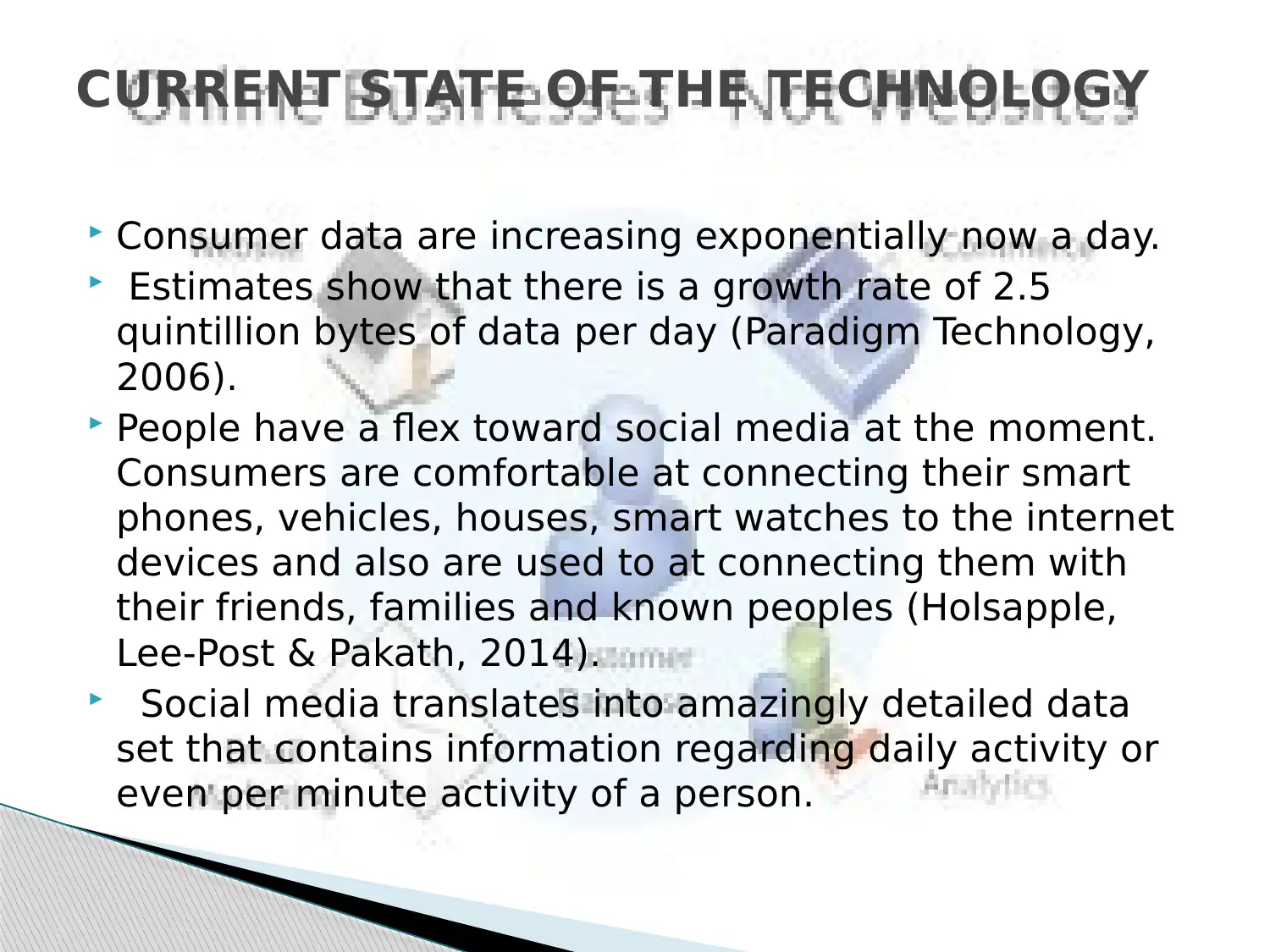
Consumer data are increasing exponentially now a day.
Estimates show that there is a growth rate of 2.5
quintillion bytes of data per day (Paradigm Technology,
2006).
People have a flex toward social media at the moment.
Consumers are comfortable at connecting their smart
phones, vehicles, houses, smart watches to the internet
devices and also are used to at connecting them with
their friends, families and known peoples (Holsapple,
Lee-Post & Pakath, 2014).
Social media translates into amazingly detailed data
set that contains information regarding daily activity or
even per minute activity of a person.
CURRENT STATE OF THE TECHNOLOGY
Estimates show that there is a growth rate of 2.5
quintillion bytes of data per day (Paradigm Technology,
2006).
People have a flex toward social media at the moment.
Consumers are comfortable at connecting their smart
phones, vehicles, houses, smart watches to the internet
devices and also are used to at connecting them with
their friends, families and known peoples (Holsapple,
Lee-Post & Pakath, 2014).
Social media translates into amazingly detailed data
set that contains information regarding daily activity or
even per minute activity of a person.
CURRENT STATE OF THE TECHNOLOGY
⊘ This is a preview!⊘
Do you want full access?
Subscribe today to unlock all pages.

Trusted by 1+ million students worldwide
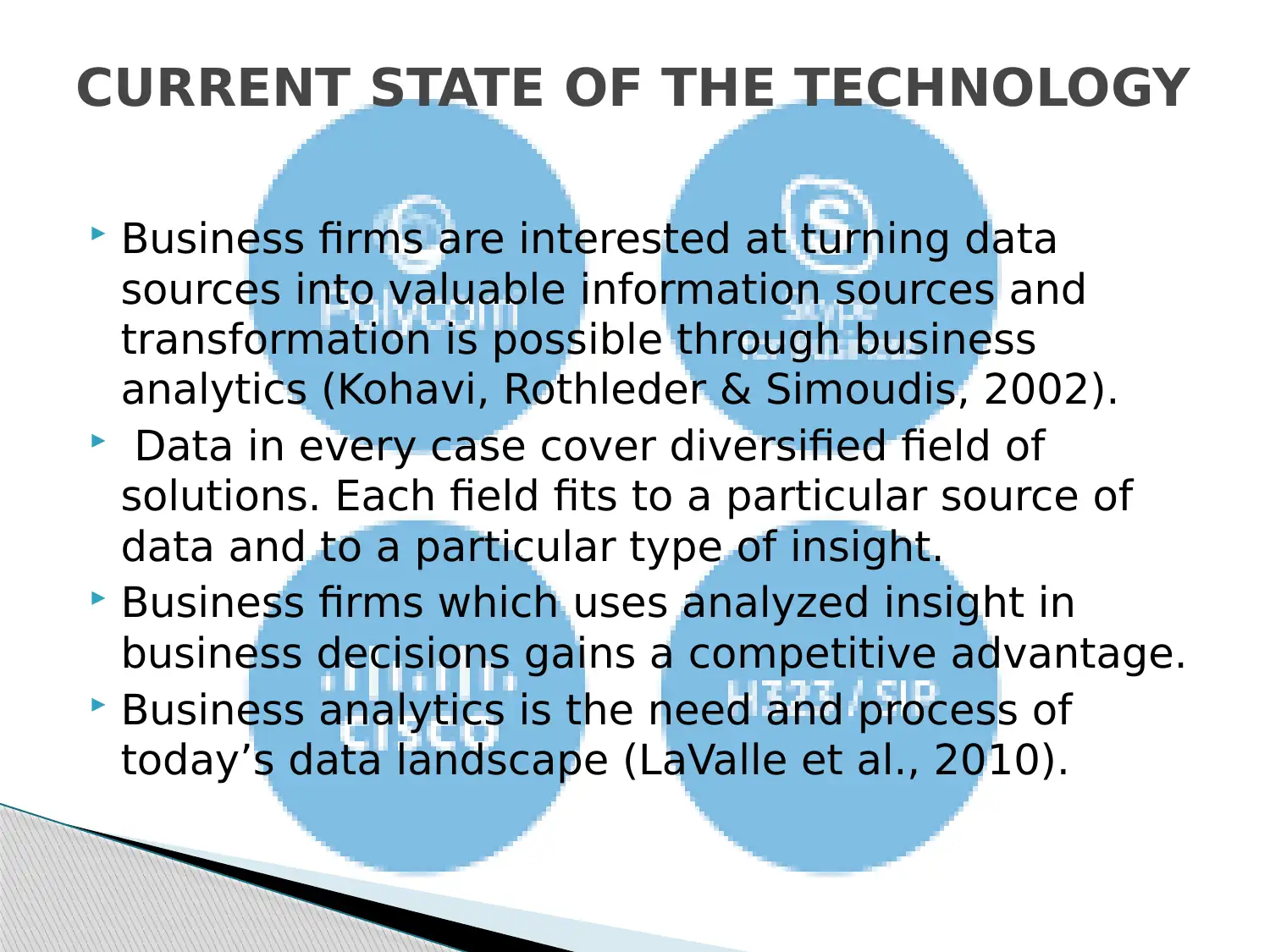
Business firms are interested at turning data
sources into valuable information sources and
transformation is possible through business
analytics (Kohavi, Rothleder & Simoudis, 2002).
Data in every case cover diversified field of
solutions. Each field fits to a particular source of
data and to a particular type of insight.
Business firms which uses analyzed insight in
business decisions gains a competitive advantage.
Business analytics is the need and process of
today’s data landscape (LaValle et al., 2010).
CURRENT STATE OF THE TECHNOLOGY
sources into valuable information sources and
transformation is possible through business
analytics (Kohavi, Rothleder & Simoudis, 2002).
Data in every case cover diversified field of
solutions. Each field fits to a particular source of
data and to a particular type of insight.
Business firms which uses analyzed insight in
business decisions gains a competitive advantage.
Business analytics is the need and process of
today’s data landscape (LaValle et al., 2010).
CURRENT STATE OF THE TECHNOLOGY
Paraphrase This Document
Need a fresh take? Get an instant paraphrase of this document with our AI Paraphraser
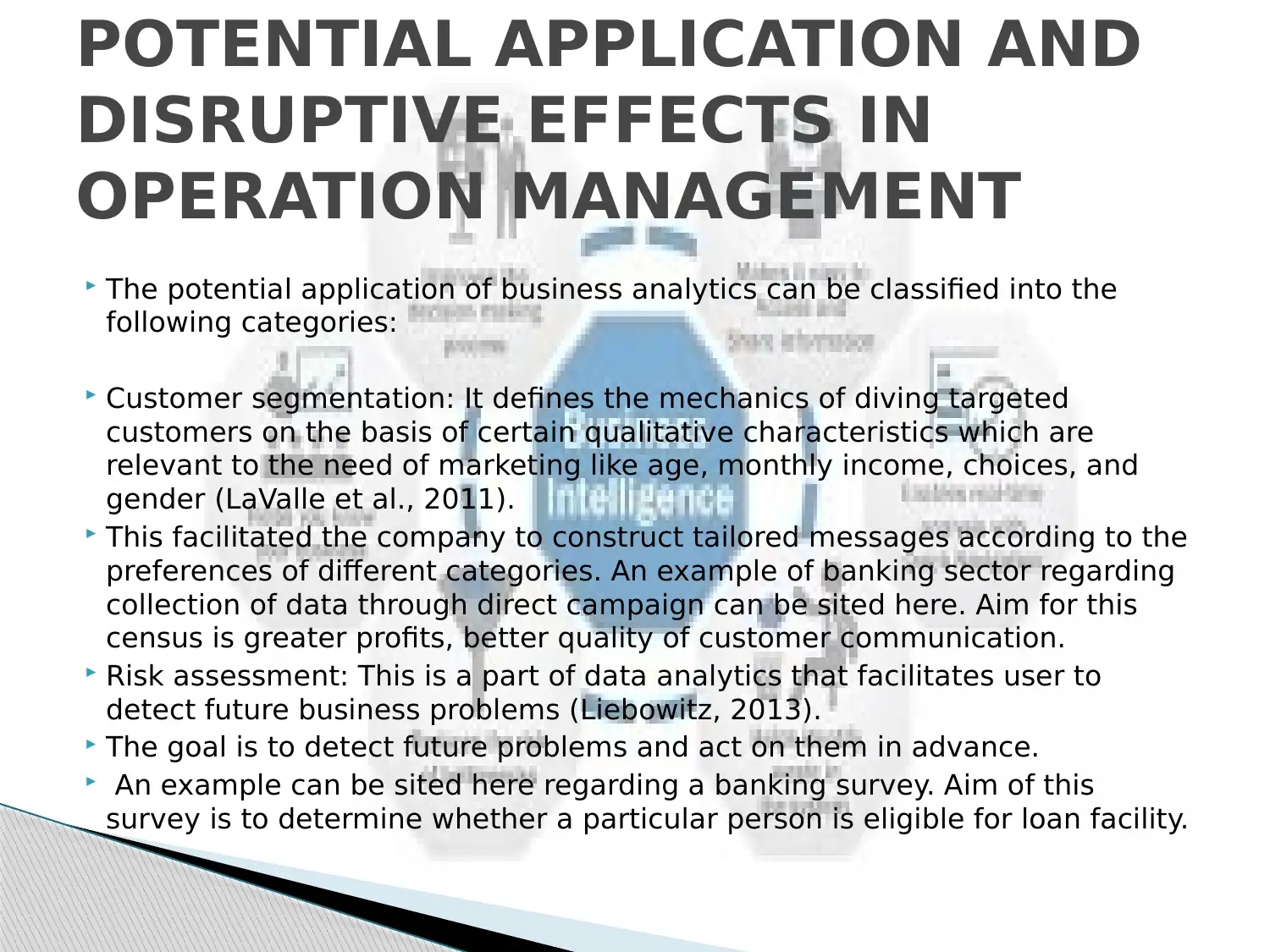
The potential application of business analytics can be classified into the
following categories:
Customer segmentation: It defines the mechanics of diving targeted
customers on the basis of certain qualitative characteristics which are
relevant to the need of marketing like age, monthly income, choices, and
gender (LaValle et al., 2011).
This facilitated the company to construct tailored messages according to the
preferences of different categories. An example of banking sector regarding
collection of data through direct campaign can be sited here. Aim for this
census is greater profits, better quality of customer communication.
Risk assessment: This is a part of data analytics that facilitates user to
detect future business problems (Liebowitz, 2013).
The goal is to detect future problems and act on them in advance.
An example can be sited here regarding a banking survey. Aim of this
survey is to determine whether a particular person is eligible for loan facility.
POTENTIAL APPLICATION AND
DISRUPTIVE EFFECTS IN
OPERATION MANAGEMENT
following categories:
Customer segmentation: It defines the mechanics of diving targeted
customers on the basis of certain qualitative characteristics which are
relevant to the need of marketing like age, monthly income, choices, and
gender (LaValle et al., 2011).
This facilitated the company to construct tailored messages according to the
preferences of different categories. An example of banking sector regarding
collection of data through direct campaign can be sited here. Aim for this
census is greater profits, better quality of customer communication.
Risk assessment: This is a part of data analytics that facilitates user to
detect future business problems (Liebowitz, 2013).
The goal is to detect future problems and act on them in advance.
An example can be sited here regarding a banking survey. Aim of this
survey is to determine whether a particular person is eligible for loan facility.
POTENTIAL APPLICATION AND
DISRUPTIVE EFFECTS IN
OPERATION MANAGEMENT
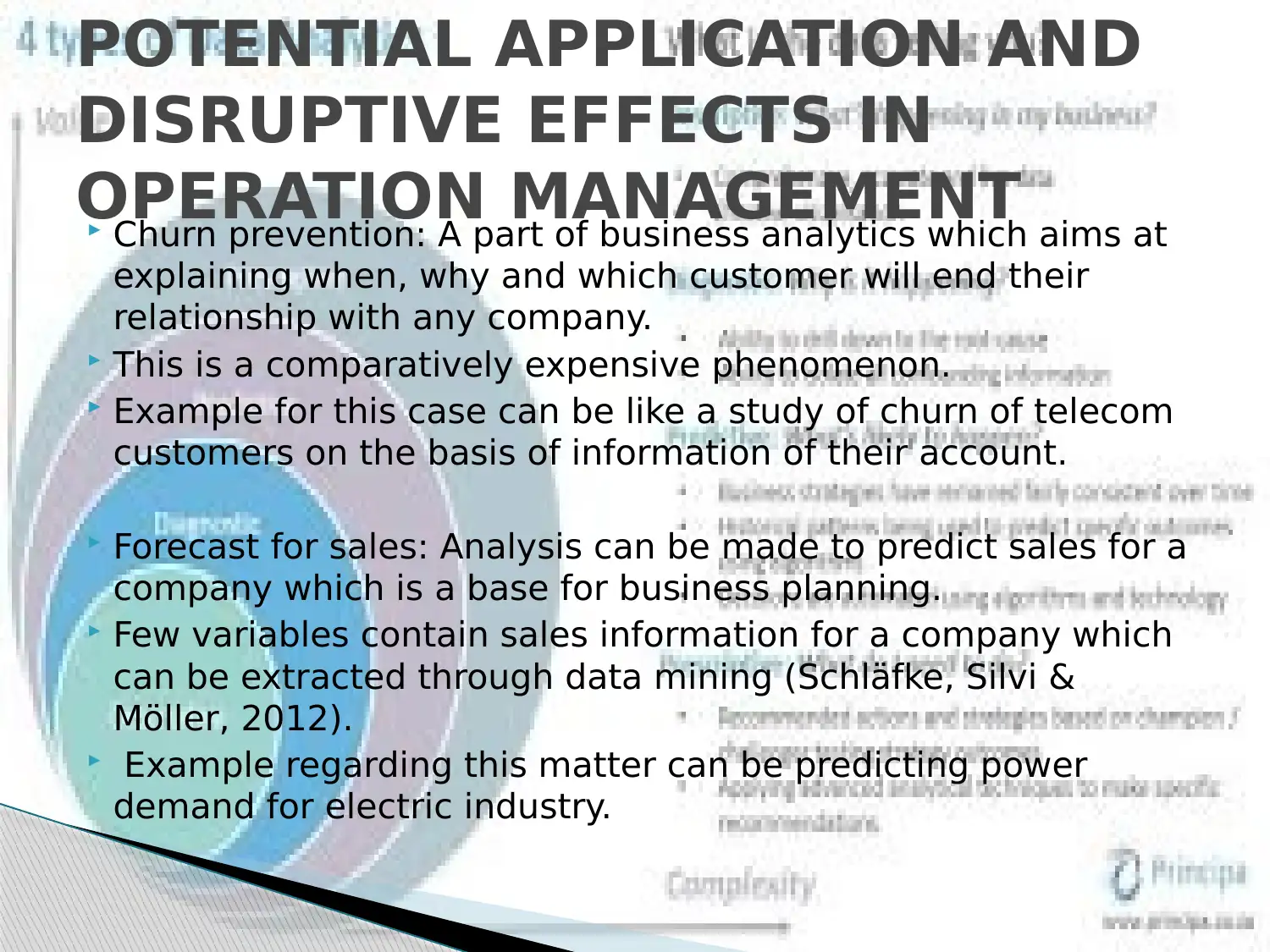
Churn prevention: A part of business analytics which aims at
explaining when, why and which customer will end their
relationship with any company.
This is a comparatively expensive phenomenon.
Example for this case can be like a study of churn of telecom
customers on the basis of information of their account.
Forecast for sales: Analysis can be made to predict sales for a
company which is a base for business planning.
Few variables contain sales information for a company which
can be extracted through data mining (Schläfke, Silvi &
Möller, 2012).
Example regarding this matter can be predicting power
demand for electric industry.
POTENTIAL APPLICATION AND
DISRUPTIVE EFFECTS IN
OPERATION MANAGEMENT
explaining when, why and which customer will end their
relationship with any company.
This is a comparatively expensive phenomenon.
Example for this case can be like a study of churn of telecom
customers on the basis of information of their account.
Forecast for sales: Analysis can be made to predict sales for a
company which is a base for business planning.
Few variables contain sales information for a company which
can be extracted through data mining (Schläfke, Silvi &
Möller, 2012).
Example regarding this matter can be predicting power
demand for electric industry.
POTENTIAL APPLICATION AND
DISRUPTIVE EFFECTS IN
OPERATION MANAGEMENT
⊘ This is a preview!⊘
Do you want full access?
Subscribe today to unlock all pages.

Trusted by 1+ million students worldwide
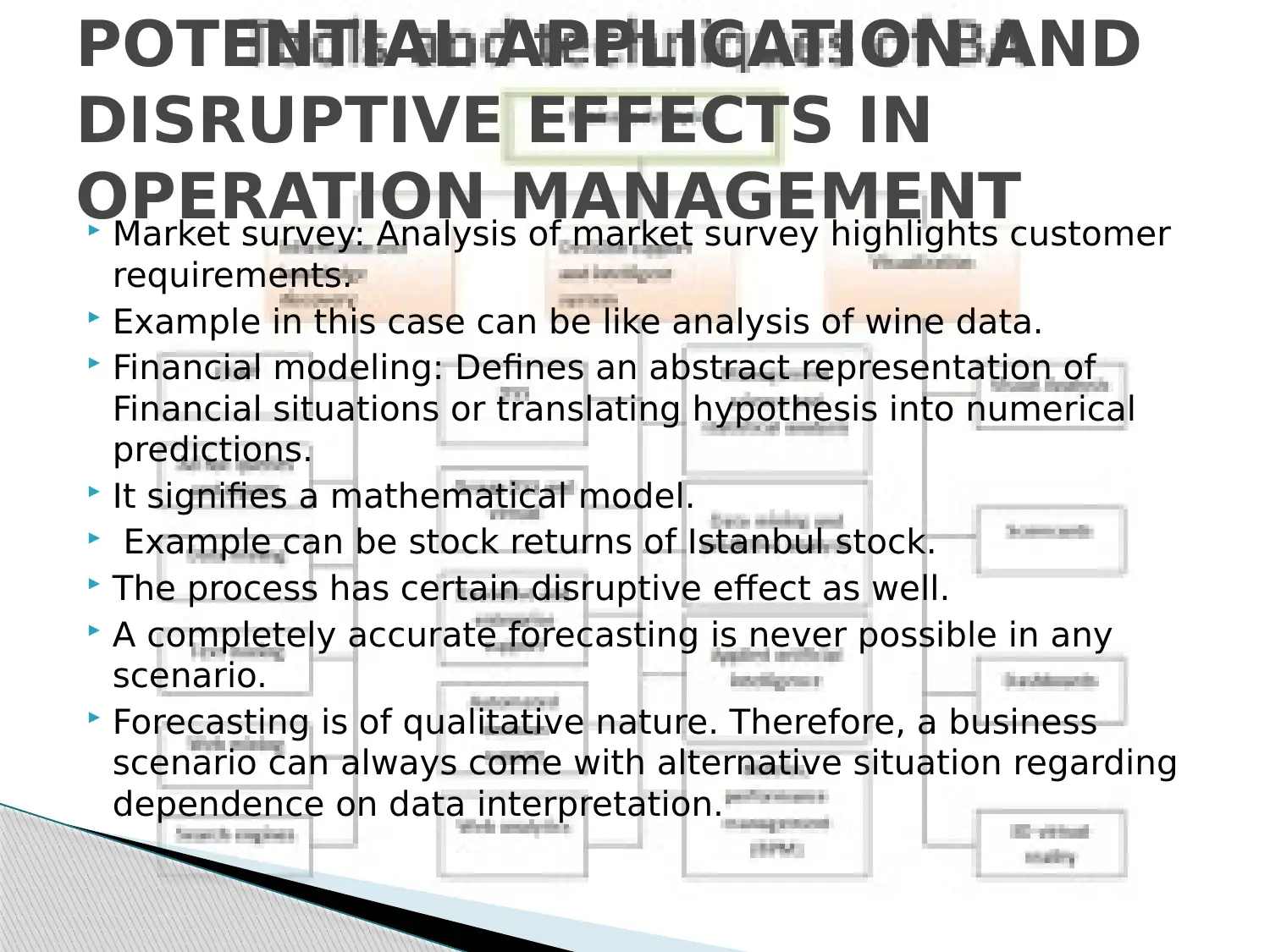
Market survey: Analysis of market survey highlights customer
requirements.
Example in this case can be like analysis of wine data.
Financial modeling: Defines an abstract representation of
Financial situations or translating hypothesis into numerical
predictions.
It signifies a mathematical model.
Example can be stock returns of Istanbul stock.
The process has certain disruptive effect as well.
A completely accurate forecasting is never possible in any
scenario.
Forecasting is of qualitative nature. Therefore, a business
scenario can always come with alternative situation regarding
dependence on data interpretation.
POTENTIAL APPLICATION AND
DISRUPTIVE EFFECTS IN
OPERATION MANAGEMENT
requirements.
Example in this case can be like analysis of wine data.
Financial modeling: Defines an abstract representation of
Financial situations or translating hypothesis into numerical
predictions.
It signifies a mathematical model.
Example can be stock returns of Istanbul stock.
The process has certain disruptive effect as well.
A completely accurate forecasting is never possible in any
scenario.
Forecasting is of qualitative nature. Therefore, a business
scenario can always come with alternative situation regarding
dependence on data interpretation.
POTENTIAL APPLICATION AND
DISRUPTIVE EFFECTS IN
OPERATION MANAGEMENT
Paraphrase This Document
Need a fresh take? Get an instant paraphrase of this document with our AI Paraphraser
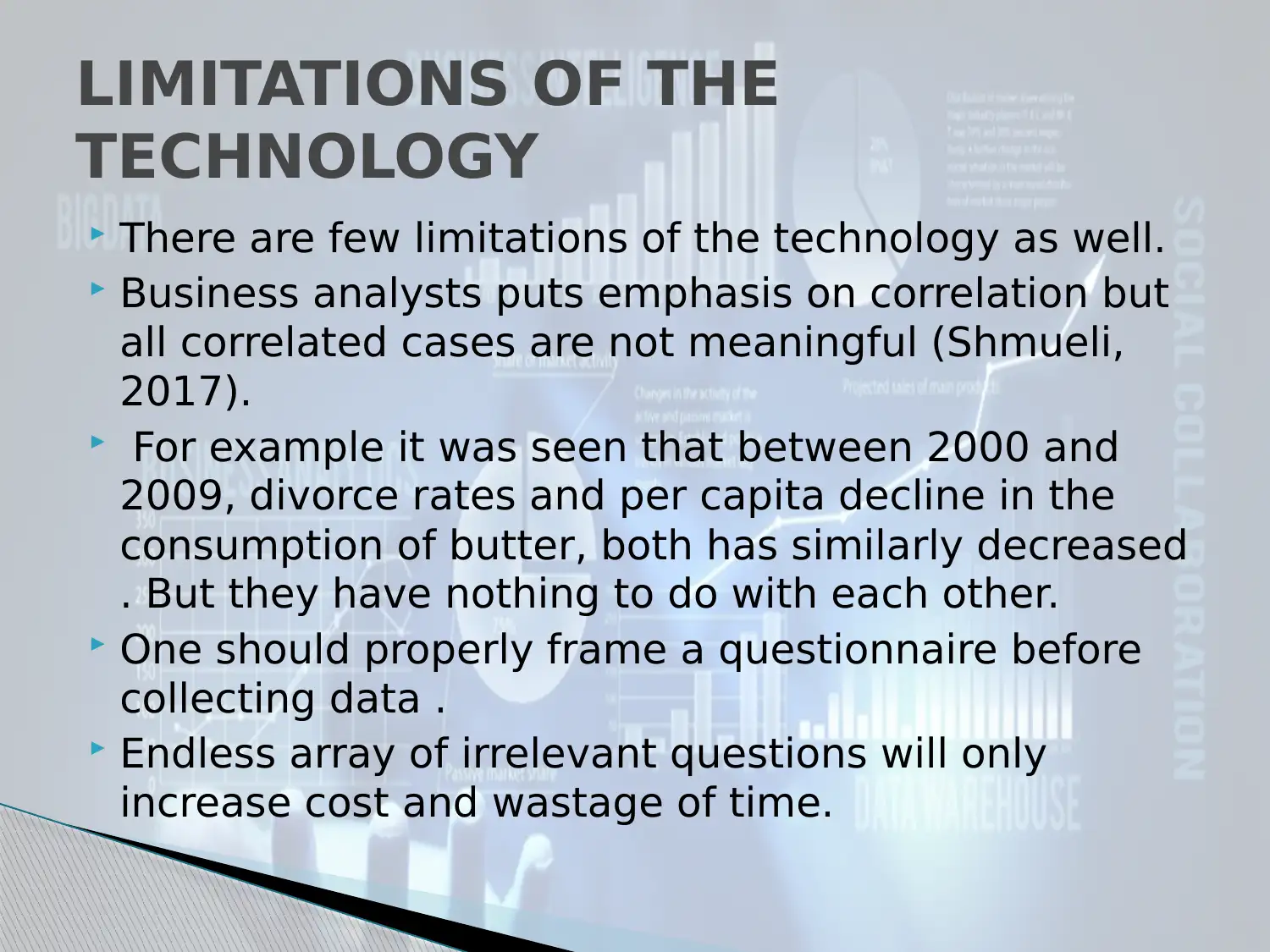
There are few limitations of the technology as well.
Business analysts puts emphasis on correlation but
all correlated cases are not meaningful (Shmueli,
2017).
For example it was seen that between 2000 and
2009, divorce rates and per capita decline in the
consumption of butter, both has similarly decreased
. But they have nothing to do with each other.
One should properly frame a questionnaire before
collecting data .
Endless array of irrelevant questions will only
increase cost and wastage of time.
LIMITATIONS OF THE
TECHNOLOGY
Business analysts puts emphasis on correlation but
all correlated cases are not meaningful (Shmueli,
2017).
For example it was seen that between 2000 and
2009, divorce rates and per capita decline in the
consumption of butter, both has similarly decreased
. But they have nothing to do with each other.
One should properly frame a questionnaire before
collecting data .
Endless array of irrelevant questions will only
increase cost and wastage of time.
LIMITATIONS OF THE
TECHNOLOGY
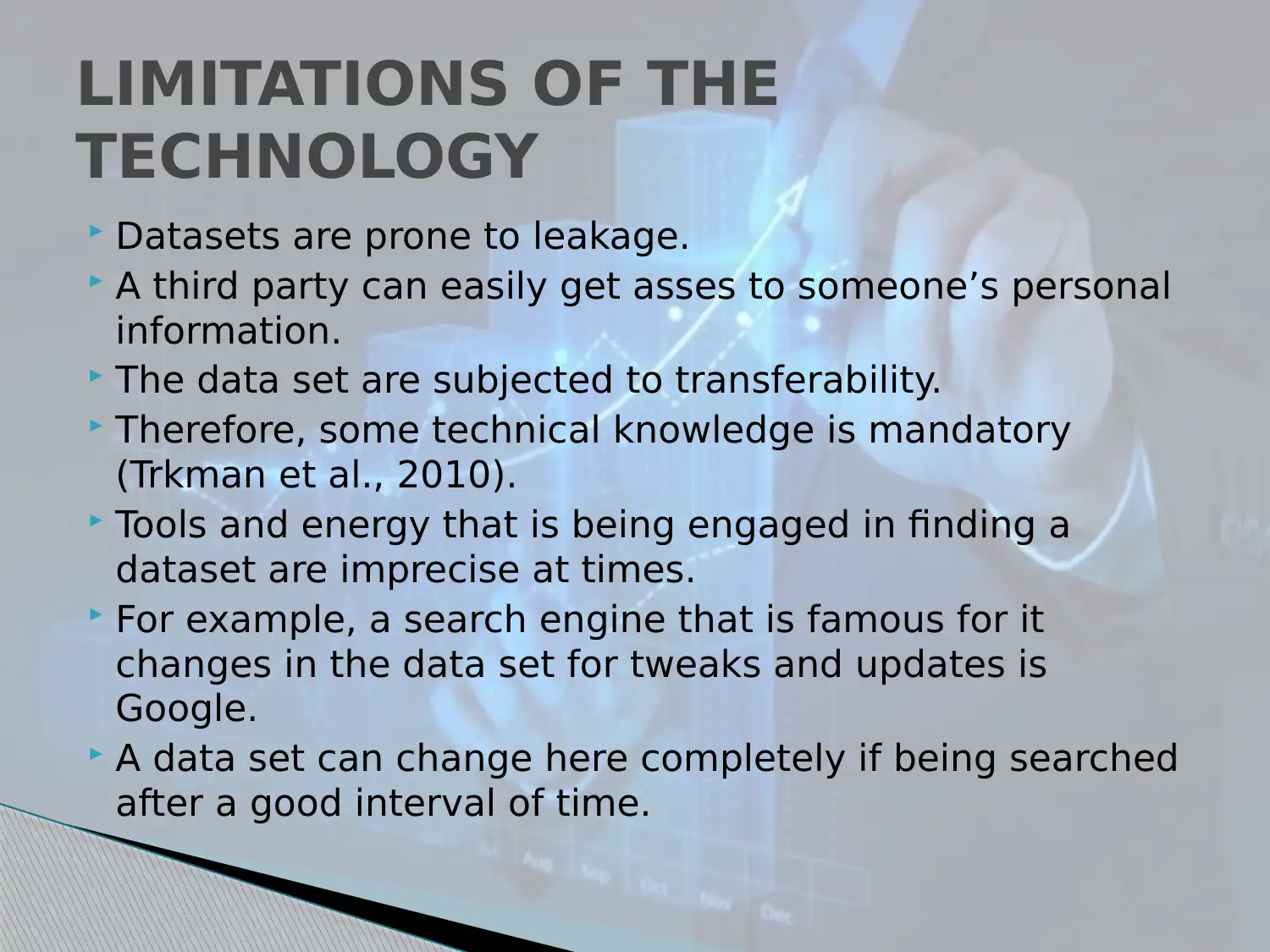
Datasets are prone to leakage.
A third party can easily get asses to someone’s personal
information.
The data set are subjected to transferability.
Therefore, some technical knowledge is mandatory
(Trkman et al., 2010).
Tools and energy that is being engaged in finding a
dataset are imprecise at times.
For example, a search engine that is famous for it
changes in the data set for tweaks and updates is
Google.
A data set can change here completely if being searched
after a good interval of time.
LIMITATIONS OF THE
TECHNOLOGY
A third party can easily get asses to someone’s personal
information.
The data set are subjected to transferability.
Therefore, some technical knowledge is mandatory
(Trkman et al., 2010).
Tools and energy that is being engaged in finding a
dataset are imprecise at times.
For example, a search engine that is famous for it
changes in the data set for tweaks and updates is
Google.
A data set can change here completely if being searched
after a good interval of time.
LIMITATIONS OF THE
TECHNOLOGY
⊘ This is a preview!⊘
Do you want full access?
Subscribe today to unlock all pages.

Trusted by 1+ million students worldwide
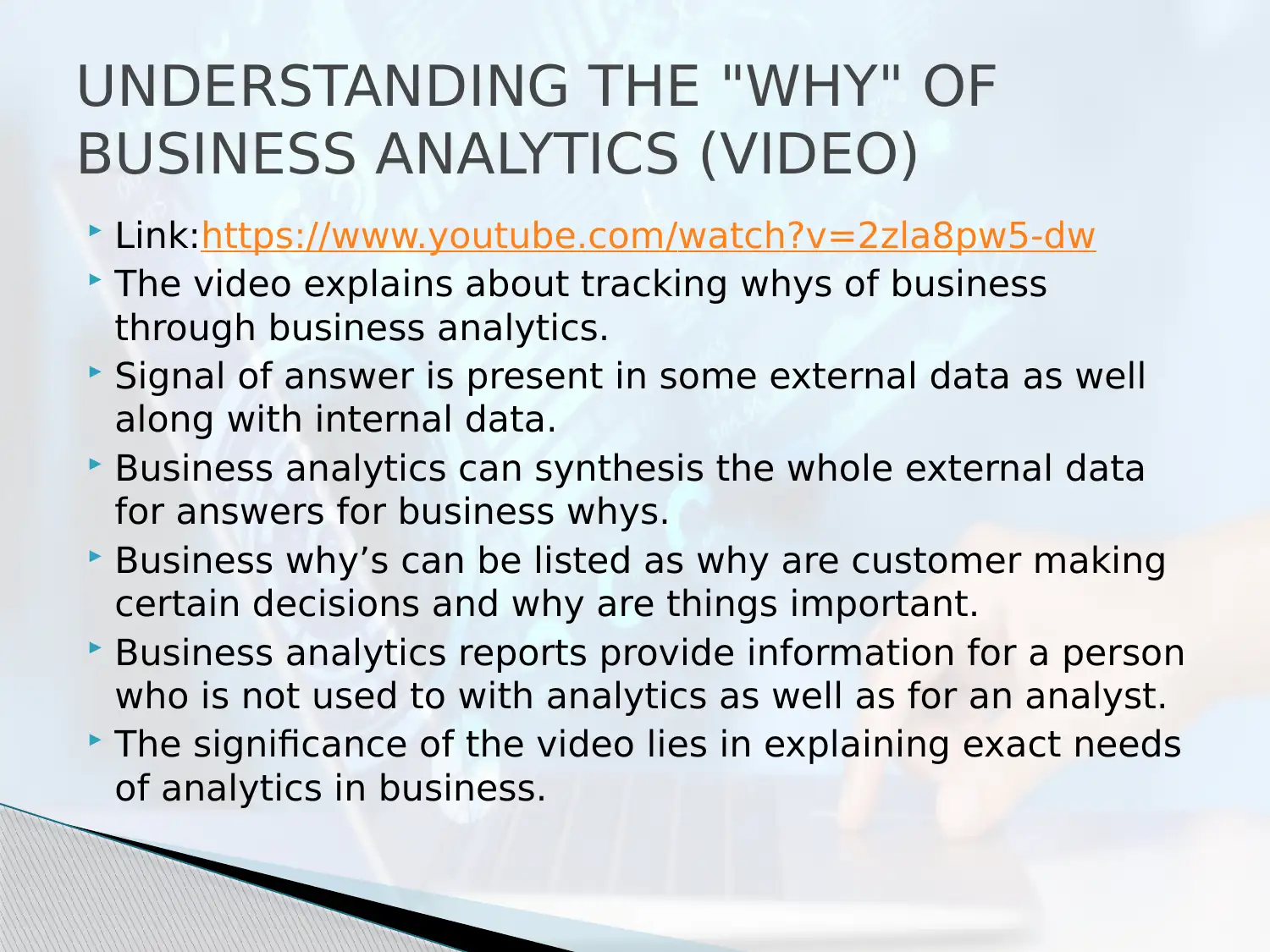
Link:https://www.youtube.com/watch?v=2zla8pw5-dw
The video explains about tracking whys of business
through business analytics.
Signal of answer is present in some external data as well
along with internal data.
Business analytics can synthesis the whole external data
for answers for business whys.
Business why’s can be listed as why are customer making
certain decisions and why are things important.
Business analytics reports provide information for a person
who is not used to with analytics as well as for an analyst.
The significance of the video lies in explaining exact needs
of analytics in business.
UNDERSTANDING THE "WHY" OF
BUSINESS ANALYTICS (VIDEO)
The video explains about tracking whys of business
through business analytics.
Signal of answer is present in some external data as well
along with internal data.
Business analytics can synthesis the whole external data
for answers for business whys.
Business why’s can be listed as why are customer making
certain decisions and why are things important.
Business analytics reports provide information for a person
who is not used to with analytics as well as for an analyst.
The significance of the video lies in explaining exact needs
of analytics in business.
UNDERSTANDING THE "WHY" OF
BUSINESS ANALYTICS (VIDEO)
Paraphrase This Document
Need a fresh take? Get an instant paraphrase of this document with our AI Paraphraser
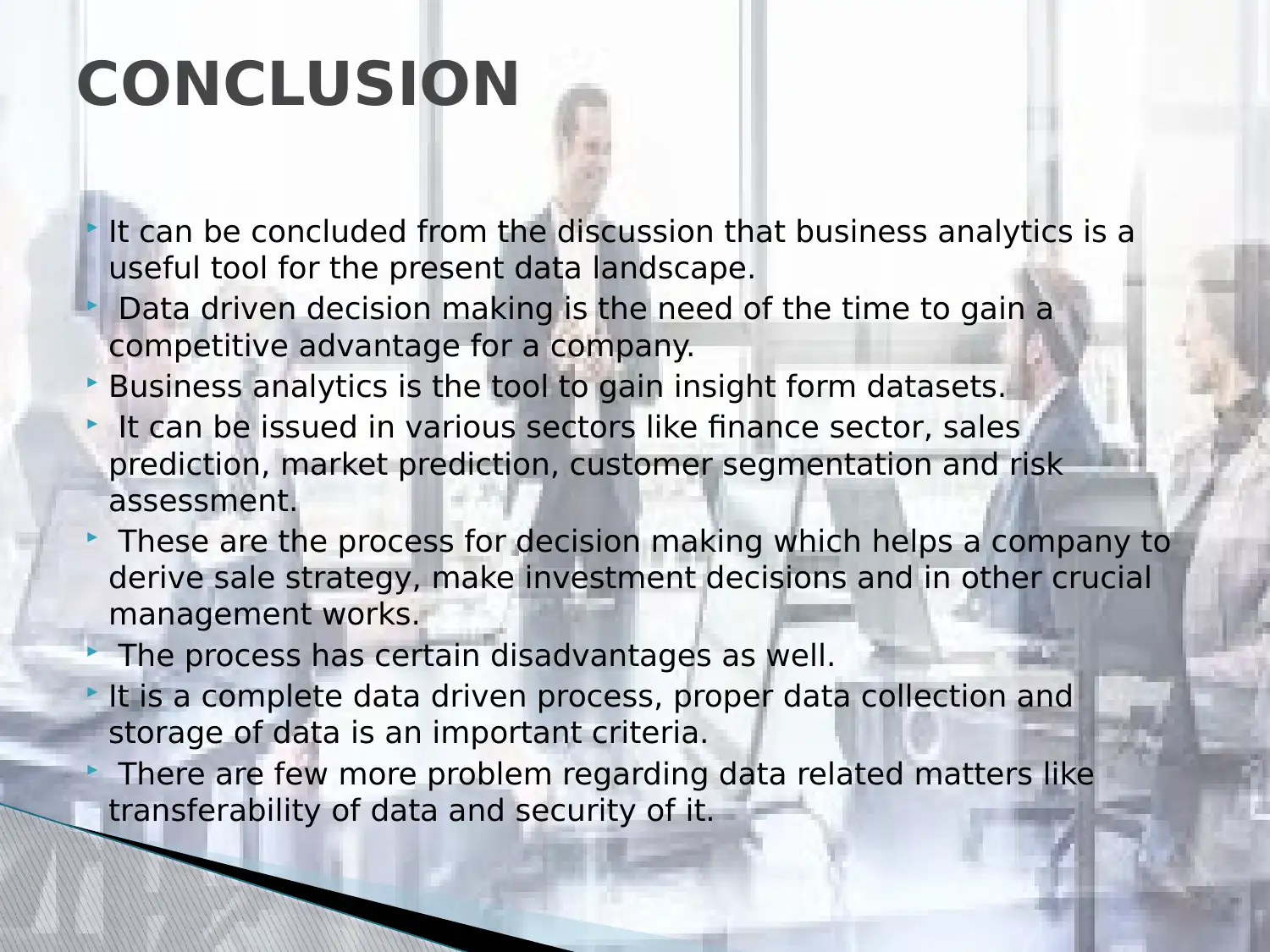
It can be concluded from the discussion that business analytics is a
useful tool for the present data landscape.
Data driven decision making is the need of the time to gain a
competitive advantage for a company.
Business analytics is the tool to gain insight form datasets.
It can be issued in various sectors like finance sector, sales
prediction, market prediction, customer segmentation and risk
assessment.
These are the process for decision making which helps a company to
derive sale strategy, make investment decisions and in other crucial
management works.
The process has certain disadvantages as well.
It is a complete data driven process, proper data collection and
storage of data is an important criteria.
There are few more problem regarding data related matters like
transferability of data and security of it.
CONCLUSION
useful tool for the present data landscape.
Data driven decision making is the need of the time to gain a
competitive advantage for a company.
Business analytics is the tool to gain insight form datasets.
It can be issued in various sectors like finance sector, sales
prediction, market prediction, customer segmentation and risk
assessment.
These are the process for decision making which helps a company to
derive sale strategy, make investment decisions and in other crucial
management works.
The process has certain disadvantages as well.
It is a complete data driven process, proper data collection and
storage of data is an important criteria.
There are few more problem regarding data related matters like
transferability of data and security of it.
CONCLUSION
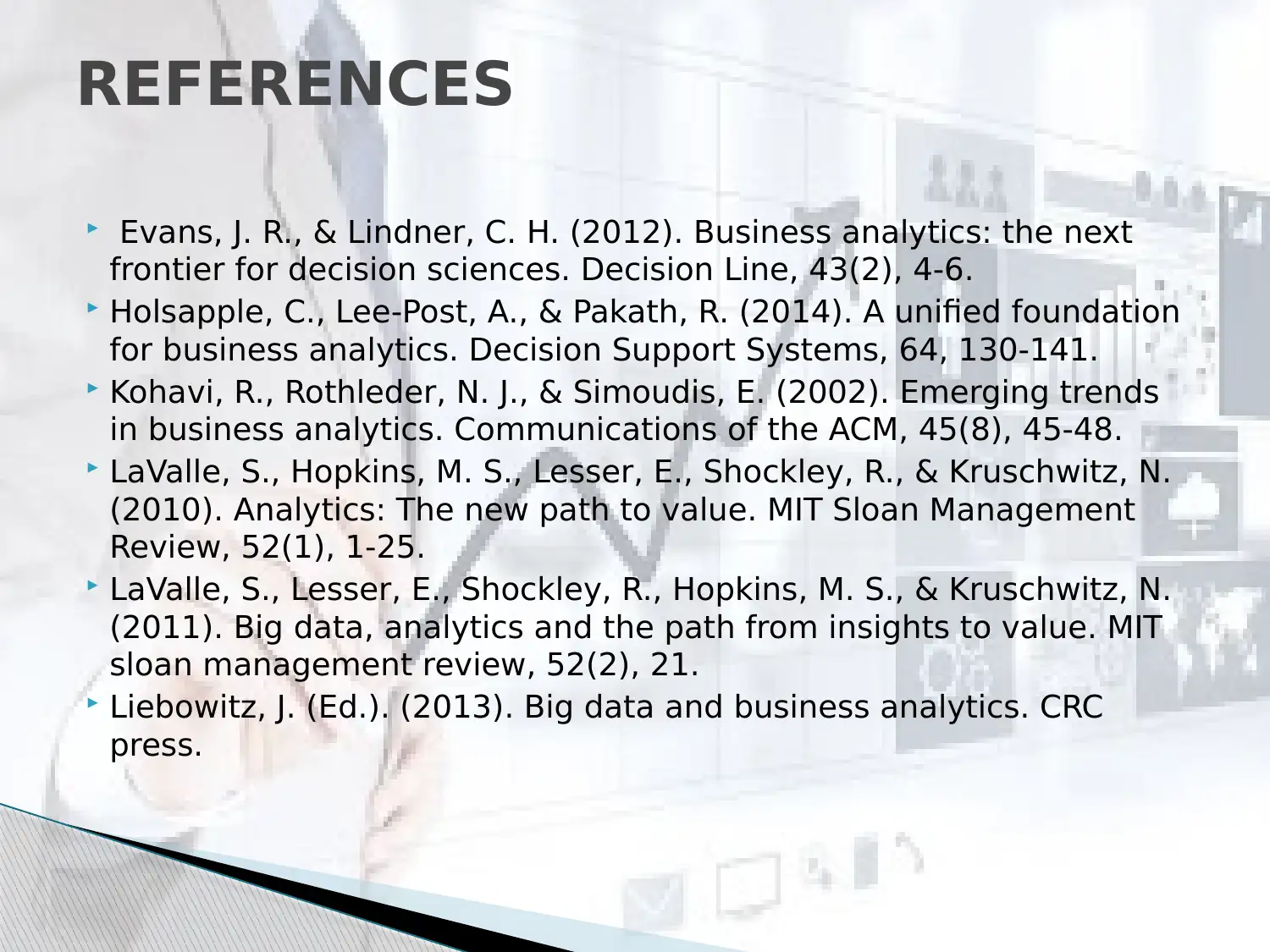
Evans, J. R., & Lindner, C. H. (2012). Business analytics: the next
frontier for decision sciences. Decision Line, 43(2), 4-6.
Holsapple, C., Lee-Post, A., & Pakath, R. (2014). A unified foundation
for business analytics. Decision Support Systems, 64, 130-141.
Kohavi, R., Rothleder, N. J., & Simoudis, E. (2002). Emerging trends
in business analytics. Communications of the ACM, 45(8), 45-48.
LaValle, S., Hopkins, M. S., Lesser, E., Shockley, R., & Kruschwitz, N.
(2010). Analytics: The new path to value. MIT Sloan Management
Review, 52(1), 1-25.
LaValle, S., Lesser, E., Shockley, R., Hopkins, M. S., & Kruschwitz, N.
(2011). Big data, analytics and the path from insights to value. MIT
sloan management review, 52(2), 21.
Liebowitz, J. (Ed.). (2013). Big data and business analytics. CRC
press.
REFERENCES
frontier for decision sciences. Decision Line, 43(2), 4-6.
Holsapple, C., Lee-Post, A., & Pakath, R. (2014). A unified foundation
for business analytics. Decision Support Systems, 64, 130-141.
Kohavi, R., Rothleder, N. J., & Simoudis, E. (2002). Emerging trends
in business analytics. Communications of the ACM, 45(8), 45-48.
LaValle, S., Hopkins, M. S., Lesser, E., Shockley, R., & Kruschwitz, N.
(2010). Analytics: The new path to value. MIT Sloan Management
Review, 52(1), 1-25.
LaValle, S., Lesser, E., Shockley, R., Hopkins, M. S., & Kruschwitz, N.
(2011). Big data, analytics and the path from insights to value. MIT
sloan management review, 52(2), 21.
Liebowitz, J. (Ed.). (2013). Big data and business analytics. CRC
press.
REFERENCES
⊘ This is a preview!⊘
Do you want full access?
Subscribe today to unlock all pages.

Trusted by 1+ million students worldwide
1 out of 14
Related Documents
Your All-in-One AI-Powered Toolkit for Academic Success.
+13062052269
info@desklib.com
Available 24*7 on WhatsApp / Email
![[object Object]](/_next/static/media/star-bottom.7253800d.svg)
Unlock your academic potential
Copyright © 2020–2025 A2Z Services. All Rights Reserved. Developed and managed by ZUCOL.





